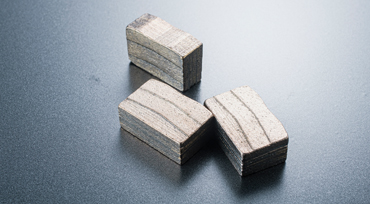The production process of diamond segments is very important. The correct production method, good raw materials and reasonable ratio of raw materials are all very important. In the following, let us know what needs to be paid attention to in producing a good diamond segment?
1. Selection of diamond grain size
When the diamond grain size is coarse and single, the segment of the saw blade will be in a sharp state, and the cutting power of the segment in this state is high. However, in this case, the bending strength of the diamond segment decreases, and the diamond is easily broken during the cutting process. In addition, the diamond in the segment is not fully utilized. When the diamond particle size is fine or coarse and fine particle size is mixed, compared with the saw blade diamond segment, the diamond usage rate will be high, resulting in high durability, but the diamond segment with this proportion of particle size will lead to lower efficiency.
Summarizing the above factors, when stone factories use diamond segments to cut marble, it is better to choose large and medium-sized diamonds will increase the cutting ability of the saw blade. However, because the hardness of marble is not high, the lifespan decline is not obvious during the cutting process, but for granite, the cutting hardness is high, so diamonds with finer particles are selected. In the selection of mesh number, some medium-sized diamonds are added to increase the cutting efficiency of the segment. Mixing the two types of diamonds will have a good cutting effect. If there is no high requirement for the cutting efficiency or life of the segment, it is more appropriate to choose a diamond powder size of 50/60#, which not only takes into account the service life, but also ensures the cutting efficiency of the segment.
2. Selection of diamond dispersion concentration
Within a certain range, when the diamond concentration changes from low to high, the sharpness and sawing power of the saw blade gradually begin to decrease, and the service life gradually extends; but if the concentration is too high, the saw blade will become dull. However, with low concentration and coarse particle size of diamond segment, the cutting efficiency will be improved.
The diamond concentration determines the sharpness and life of the segment. The point where the two curves intersect is where the sharpness and life are better. Through continuous testing, a suitable ratio is found, which is generally neither too high nor too low.
Under the circumstance of the different effects of different parts of the segment during cutting, it is better to choose different concentrations (That is, in a three-layer or more-layer structure, a lower concentration of diamond can be used in the middle layer, which is better to form a layer and take into account the cutting function), the segment forms a middle groove during the saw blade process, which is beneficial to avoid the deflection of the saw blade, thereby improving the stone processing quality.
3. The choice of diamond strength
The strength of diamond is an important target to ensure cutting function. Excessive strength will make the crystal not easy to be broken, and the abrasive grains will be polished during use, and the sharpness will be reduced, resulting in the inability of the diamond segment to work. When the diamond strength is low, it is easily broken after being impacted, and it is difficult to cut. The choice of strength needs to be determined according to the situation of the stone. For cutting soft stone, choosing a diamond with lower or moderate strength is better, and for cutting hard stone, choosing a diamond with high strength is better.
4. Selection of matrix bond
The cutting performance of the diamond segment is not only determined by the diamond, but by the rationality of the combination of the diamond and the matrix bond. For cutting soft stone, such as marble, it is recommended to use a copper-based segment (Mainly copper powder, adding some cobalt powder, Zn, Sn and other elements, in the high temperature sintering process, through liquid phase sintering and solid phase sintering, to form a binder suitable for cutting soft stone). If it is cutting harder stone, such as granite, it is better to use an iron-based blade. This iron-based blade will be more wear-resistant, and the hardness will be higher. When cutting granite, it will have a longer life and hold the diamond.
5. Selection of sintering process
With the increase of temperature, the degree of densification of the matrix increases, and the flexural strength also increases. In addition, with the extension of the holding time, the flexural strength of the blank matrix and diamond agglomerates first increases and then decreases. 120s sintering process at 800℃ can meet the functional requirements. However, it is worth noting that diamond will be carbonized at 700 degrees Celsius and gradually transformed into graphite. In order to reduce the process of diamond graphitization, there are more different combinations of sintering time and sintering temperature.

Several Important Parameter Selections in the Production Process of Diamond Segments
Publish date:2022-09-30 14:12:44 Article From:LINSING diamond tools Clicks:










